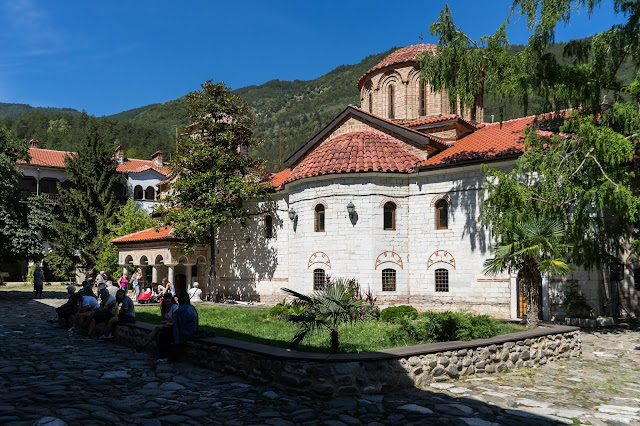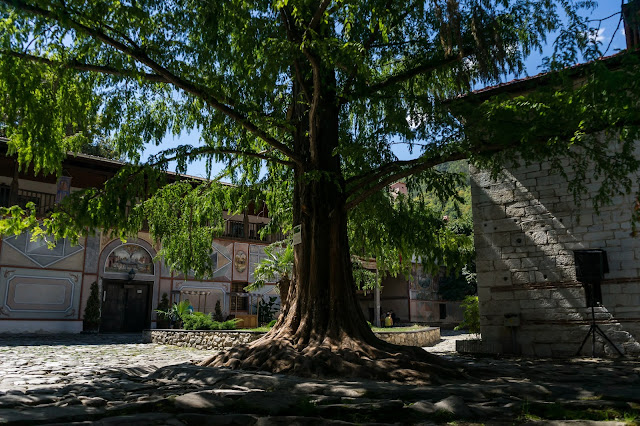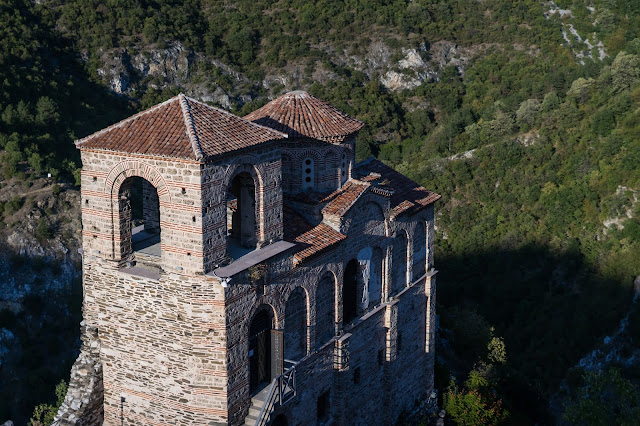2021 保加利亞旅遊攻略。奇妙的橋樑-巴科科沃修道院-阿森要塞-普羅夫迪夫一日遊。TOP ATTRACTIONS IN PLOVDIV area, BULGARIA
大家好!我是住在聖托里尼的台灣女攝影師,是當地合法攝影師,
國外旅居十年,旅遊世界58國,歐洲28國,度假打工4個不同國家,
希望可以跟大家分享我的旅遊攝影,私藏景點和長居聖島的生活體驗。
更多旅遊資訊歡迎到我個人網站 Find out more please visit my website:
https://totokuophotography.com/
想要了解更多歐洲旅遊好吃好拍景點臉書粉絲頁 :
探索13世紀的城堡,Asen's Fortress堡壘以及擁有壁畫和壁畫的11世紀Bachkovo Monastery修道院,然後欣賞著名的Wonderful Bridges自然雕刻的橋樑。
Bachkovo修道院始建於1083年,是保加利亞第二大修道院。在修道院內,您將參觀始建於1604年的聖母瑪利亞主教堂,其中保存著公元11-12世紀聖瑪麗的一個珍貴的奇蹟聖像,以及保存完好的原始壁畫。修道院食堂是該建築群中的另一顆明珠,保留了1643年以來的彩色壁畫。食堂的參觀是可選的,但要支付小額入場費。在世界末日壁畫的內部,您將目睹許多先知,聖僧侶,古代哲學家和作家(例如蘇格拉底,亞里士多德,柏拉圖等)的圖像。在第二個修道院院子裡,您最終將參觀聖尼古拉教堂, 1834年和1837年。對於自然愛好者來說,您還可以繼續在Bachkovo修道院附近的紅牆自然保護區中短暫步行,繼續遊覽,在那裡您會發現美麗的瀑布,綠色的草地和茂密的森林。
The Bachkovo Monastery “Assumption of the Virgin” is located in the southern part of the village Bachkovo, 10 kilometers south of Asenovgrad. The monastery was founded in 1083 by the Georgian Gregoriy Bakuriani, who donated the land. For a long time, the monastery was Georgian. The two-story ossuary some 400 meters from the monastery was built during the monastery’s earliest days.
At the end of the 12th century and the beginning of the 13th century, The Holy Archangels Church was built for services during the winter months. It was attached to the terrace on the second floor of the west wing where the monks had their cells. It is thought that after the fall of Bulgaria to the Ottomans at the end of the 14th century, Evtimiy, Bulgaria’s last patriarch at that time, was exiled to the Bachkovo Monastery.
Construction on the new monastery began at the end of the 16th century, most likely with the eastern wing and the fortified main entrance. In 1601, the southern wing was rebuilt, where the refectory now stands, with its spacious dining area and marble table. Visitors will note that the year of the table’s construction is carved on it. In 1864, a mural was painted on the northern wall of the dining hall, “The Presentation of the Miraculous Icon.” In 1604, The Assumption of the Virgin Cathedral was constructed, which has three naves, an apse, a narthex, and a cupola.
In 1833, the vegetable garden was expanded and new gardens were planted. From 1834-1837, a third church was built, dedicated to Saint Nikola. The famous Bulgarian icon painter Zahariy Zograf (1810-1853), executed the images in the church’s interior from 1838-1840, and in 1841 he completed the frescoes on the exterior of The Holy Archangels Church.
In the cathedral, there is an icon from 1311 known as The Holy Mother of God Icon, with a silver repousse cover. This icon is believed to have miraculous powers.
Visitors to monastery may also view other icons, silver repousse covers for copies of the Gospels, and other works of art from the 16th to the 19th centuries. Treasures from the 17th century include a carved wooden icon stand with gold ornamentation and the cathedrals royal doors. The Bulgarian Exarch Stefan I (1878-1957) is buried at the monastery, as is the Bulgarian Patriarch Kiril (1901-1971). There is a museum on the grounds where some of the oldest artifacts connected with the history of the monastery are on display.
A favorite gathering place for pilgrims and visitors is the monastery’s courtyard, with its impressive trees, such as a Paradise apple tree and a Chinese fir. The monastery is still functioning, and the monks offer overnight accommodations. The church’s annual holiday is on August 15.
Visitors can purchase informative materials, books, souvenirs, and icons on the premises. The path leading to the monastery is lined with small shops and stands that sell ceramic items, wood carvings, and other souvenirs.
Bachkovo Monastery offers rooms (10 lv to 15 lv per bed) but be aware that only married couples can share a room and some travellers report being turned away. Enquire upstairs in the reception office or, better yet, online in advance.
Take any bus to Smolyan from Plovdiv’s Rodopi bus station (5 lv), disembark at the turn-off about 1.2km south of Bachkovo village and walk about 500m uphill. There are also direct buses half-hourly (6 lv).
Bachkovo
Phone03327-2277
Websitewww.bachkovskimanastir.com
Hours7am-8pm Jun-Sep, to 7pm Oct-May
Pricemonastery free, refectory 6 lv, museum 2 lv, ossuary 6 lv
奇妙的橋樑位於1450 m。在美麗的羅多彼山脈的中心。這種獨特的自然現象由一條小河上的兩座岩石橋(高度為45 m)組成。大理石橋是由地震和曾經高水位的河流和風的侵蝕作用所形成的。這些傑出的自然橋樑與巴赫科沃修道院和阿森要塞一起,也被列為保加利亞100個國家級旅遊勝地。在夏季的周末,巴爾幹半島上最長的拉鍊線(240 m)可延伸至兩座橋樑之間,以供喜歡冒險的旅客使用。滑索行駛在流經兩座岩石橋的河上方約50 m處。
Chudnite Mostove (The Wonderful Bridges) is a rock phenomenon, also known as the Skalnite Mostove (The Rock Bridges). It is situated in the karst valley of the river Erkyupriya in the West Rhodope mountain, 1450 above the sea level, at the foot of Golyam Persenk peak (2091). The rock phenomenon is situated at a distance of 80 km south from Plovdiv, 35 km north-west from Chepelare and only 5 km north-west from the village of Zabardo. The bridges were declared a natural landmark by Decree of the Council of Ministers No 4941 of 18.07.1949.
The walkway from the village of Orehovo to the village of Zabardo passes by the Wonderful Bridges.
In the past, the bridges had been one entire cave, formed under the destructive activity of the river waters. Parts of it were collapsing with time, forming majestic marble bridges. The large bridge is about 15 meters wide in its wider parts and almost 100 meters long. It consists of three arches, as the largest one is 45 meters high and 40 meters wide. The small bridge is at a distance of 200 meters from the large one along the river current. It is impassable, 60 meters long, with total height of 50 meters, and the height of the arch is 30 meters. There is also a really small third bridge after it, which is a ponor cave, in which the waters of Erkyupriya river disappear, to appear again on the surface 3 kilometers farther.
跟著 Toto Kuo 遊 #馬其頓/ #保加利亞 / #羅馬尼亞
#WonderfulBridge 是保加利亞南部羅多彼山脈的天然拱門。這是一個壯觀的自然現象,由小河上方的三座天然橋組成,這是羅多彼人最有趣的岩石現象之一。拱橋(橋樑)過去是由河流(Aidarsko Dere)形成的。
The Marvelous Bridges or Wonderful Bridges are natural arches in the Rhodope Mountains of southern Bulgaria. This is a spectacular natural phenomenons, consisting of three natural bridges above the small river, which form one of the most interesting rock phenomena in the Rhodopes. The archs (bridges) were formed by the river (Aidarsko Dere)
A legend speaks of the creation of the Wonderful Bridges. Many years ago, there were a lot of shepherds in the locality of the village of Zabardo. A dragon appeared from somewhere and began to ravage their herds. For many years the shepherds suffered from the dragon’s raids. Finally, they came up with a way to outwit him. They loaded a donkey with tinder (a dry substance made of wood fungus which is used for making fire from flint and steel), set it on fire and sent it against the dragon.
The dragon swallowed the donkey together with the tinder which was burning slowly but surely. The dragon went crazy and desperately tried to escape, and finally found a small hole in the ground. Its huge body opened the crack. Years later, when the dragon bones decomposed, the large arched bridges remained. This way the Wonderful Bridges appeared according to the legend.
The two large bridges are safeguarded and accommodated for the touristic needs. Passing is allowed over and under them.
An option for accommodation is offered by the huts situated in close proximity to the sites.
The magic of The Wonderful Bridges Deep and high in the majestic Rodope Mountains, there is a magnificent site, called The Wonderful Bridges. This is one of the most attractive and most impressive natural phenomenon in Europe
The Wonderful Bridges are situated in the central Rodopi Mountains along the east slopes of the Chernatitsa hill on 1450 meters above the sea level. They are located 80 kilometers south of Plovdiv, 35 kilometers north-west of Chepelare, and only 5 kilometers north-west of the village of Zabardo. Actually The Wonderful Bridges are marble arcs, connecting the shores of Dalbok Dol (Deep Gorge) River. Thousand years ago there was a cave in the bed of river which collapsed after an earthquake. The river washed away the stone debris during the centuries and the beautiful bridges appeared.
奇妙的橋樑是一種自然現象,據信是在一條深溝壑的小河水域可能是地震的情況下,在元古代大理石形成的先前洞穴坍塌期間形成的。
阿森的堡壘-保加利亞保存最完好的堡壘之一。真正令人嘆為觀止的風景,背後的景色和歷史!
建於13世紀的非凡的阿森堡(Asen’s Fortress)位於普羅夫迪夫(Plovdiv)以南30分鐘的羅多彼山脈索姆(Rhodope Mountains som)的全景山丘上。在這裡,您還會發現保存完好的基督教東正教教堂,其歷史可追溯到13世紀,上面塗有一些真實的肖像畫。在堡壘的頂部,您將欣賞羅多彼山脈,阿塞諾夫格勒鎮,色雷斯谷和壯麗的巴爾干山脈的360度全景圖,遠處最高的Botev山頂。
The fortress has existed since the times of the Thracians /3rd millennium BC/. It was enlarged and fortified in 1231 during the reign of Tsar Ivan Asen II and it was named after him. The fortress had its own army and administration. It was conquered by the crusaders during the Third Crusade and it was destroyed to a great extent during the fall of Bulgaria under the Turkish yoke. “The Holy Mother from Petrich” church is the sole completely preserved building.
The natural cliff massif where the fortress is situated comprises an area of 12 hectares. With drops that are almost vertical and at times even overhanging above the river below, it is impregnable on three sides. Its strategic location and natural defenses explain why it has been used since the days of the Thracians, who fortified it in the 5th century BC.
The fact that the fortress has been controlled by the Thracians, Romans, Byzantines, Crusaders, Bulgarians, and Ottomans, and each era has left its archeological record, all preserved in the historical museum in Asenovgrad, explains why the Medieval Asen’s Fortress is one of the most-visited tourist destinations in the Asenovgrad region.
Asen’s Fortress offers a clear picture of Medieval military fortification and gives visitors, if only for a little while, the feeling that they have been transported back to a much earlier age. The approach to the church and feudal castle is by way of a narrow path, to the left of which
There is a parking area at the entrance to the fortress. Asen’s Fortress was declared an architectural monument in Issue 20 of the State Records of 1973. Visitors can continue on to the Saint Atanasi Chapel, Saint Nikola Chaple, Saint Dimitar Chapel, and Saint Iliya Chapel, where the environs offer areas for rest and picnics. An trail allows hikers to continue along the Roman Road between Asenovgrad and Bachkovo Monastery. In the Asenovgrad region there are 5 monasteries, 33 churches (14 in the city itself), and more than 40 chapels. Along with these, Asen’s Fortress comprises part of the cultural itinerary through the Holy Mountains of the Rhodopes.
Ancient Theater of Philippopolis
The Roman theatre of Philippopolis is one of the world's best-preserved ancient Roman theatres, located in the city center of modern Plovdiv, Bulgaria. It was constructed in the 90s of the 1st century AD, probably during the reign of Domitian. The theatre can host between 5,000 and 7,000 spectators and it is currently in use.
普羅夫迪夫羅馬劇場(Plovdiv Roman theatre)是位於保加利亞普羅夫迪夫的一座古羅馬劇場。普多夫迪夫羅馬劇場是現在世界上保存狀態最好的古羅馬劇場之一。
羅馬帝國時期,是普羅夫迪夫歷史上最輝煌時期,古羅馬人在此修建了大量公共建築、教堂、公共浴室和劇院等。這座保加利亞保存最完好的古劇場,是在特拉罕皇帝統治期間的二世紀建造。後在一次施工中偶然發現。
古羅馬露天劇場,全部用白色大理石依山砌成,圓柱形希臘古典式建築,舞台高3.1米,兩邊保留著栩栩如生的大理石雕像,20排3500個大理石座位,呈扇形圍著舞台。雖然有些坍塌,大理石雕像殘破斑駁,依然可見舊日風采。經過徹底的恢復,現在還常用於各種演出。
普羅夫迪夫(Plovdiv)是僅次於首都的第二大城,普羅夫迪夫州的首府。這座歷史悠久的古城,有超過6000年的歷史,甚至比我們熟知的羅馬、雅典、君士坦丁堡的年代還要久遠,是歐洲最古老的城市之一。最早為色雷斯人村落。
十九世紀八十年代,溝通中歐和西亞的國際鐵路幹線建成後,貝爾格萊德至伊斯坦布爾的國際幹線由此經過,普羅夫迪夫發展成為保加利亞南部最大的交通和貿易中心。
普羅夫迪夫雖然屢遭戰亂和地震,幾度興衰,但是全城遍布古代遺址和羅馬道路,古蹟眾多,是保加利亞最具豐富歷史底蘊的城市。
在普羅夫迪夫全部景點觀光中排第1的是“古羅馬露天劇場”,位於老城南門。
其他保加利亞推薦景點
All photos by Toto Kuo
Wedding Photography / Santorini Photo Tour
歐洲婚紗 / 蜜月側拍 / 聖托里尼旅拍
Facebook Page - https://www.facebook.com/budapestsogood/
Instagram - https://www.instagram.com/totokuo/
Website - https://totokuophotography.com/
Food Blog - http://totokuo.blogspot.hu/
email : toto11046179@gmail.com
WeChat ID : totokuophoto
Line ID : toto1104










































Comments
Post a Comment